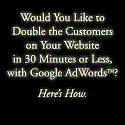

Create the Best Pay-Per-Click Landing Page in 7 Easy Steps
This is a guest contribution from Poulami Ghosh of PPC Ads Management.
If conversion rates really matter to you, you should be aware that every marketing campaign has to have a dedicated landing page. This is particularly true with regard to PPC where you have to pay for every single click. Ask any PPC company and it will tell you the same thing. However, it is not enough to know that you should use a landing page. You also have to know how to craft one, so that your marketing efforts rise above the average and become exceptional.
There are seven steps to creating an effective landing page. In order to explain them better, let me create a fictitious organization first. Let’s name it SaaSProject. It is an online solution for project management, specifically created for SaaS (Software as a Service) businesses. The message they want to convey is that their platform has been specifically designed for the online software industry and comprises features closely associated with how SaaS businesses function.
Setting Your Campaign Goal or Objective
The main aim of this campaign will be to accumulate leads, by offering informative content about handling SaaS projects.
Majority of the marketing done by SaaSProject is content marketing. Thus, a PDF guide on the subject will be written so that it can be given away in exchange of data gathered from people.
Another objective is to get the maximum number of leads possible for opting in to watch a demo of the product. This goal can be achieved in two ways, both of which will be explained by me when I come to the page design.
Explain the Pain of the Customer As Well As Its Relief
Penning down a pain statement enables you to concentrate on the needs of your customer, and also express better how that pain is addressed by your solution. Let us try to understand it better with our example.
The Pain
Software for project management is either very complex so that no team member wants to use it, or too simplistic so that it is not configurable enough to do what it is required to.
The Pain Relief
SaaSProject was particularly designed, keeping in mind a SaaS business model. Its functionality is role-specific so that it directly speaks to designers, developers and advertisers. There are comprehensive to-do lists for developers with complete Github integration. A PSD can be uploaded by designers, which changes into a sequence of layer previews intended for stakeholders. Again, writers have versioning, copy commenting as well as approval modes. What is more, there is a 10,000 feet-view mode for the project manager for easily managing the project with one view.
You are really enthusiastic about starting this organization with me now, right?
A balanced approach is given by these two accounts for narrating your story. Your prospects have to be addressed in a way that is understood by them, based on consideration of their most important concerns.
Write an Engaging Campaign Story
Next, you have to create a compelling campaign story that weaves the pain as well as the pain relief descriptions together into a narrative which you can use as a parameter first for the ebook and then for your landing page.
How to Write an Effective Campaign Story?
Make use of a story skeleton to simplify the writing process. The Freytag Pyramid defines a common plot structure, which involves breaking a narrative down into five stages, namely: exposition, rising action, climax, falling action and conclusion. This structure can be used to craft your base story, after which it has to be translated into the functional parts of a landing page.
Create Your Form
A form is not just a collection of data requests. An entire landing page can be created only with a form. Any PPC company will vouch for that.
Since we have the story with us now, we have to begin the process of its translation to a landing page. In this case, it is always advisable to use the inside-out approach instead of the more traditional top-down one.
Your form comprises the following components:
- A headline for introducing the purpose of the form.
- A description involving bullets for highlighting the advantage and contents of what is being given away by you upon completion.
- A call-to-action.
- The form with vivid form fields (attention can be captured by original questions and label names).
- Trust links or statements.
- A context-enhancement or closing urgency statement.
I mentioned in Step one that there were two ways in which people could be asked to register for the demo. They are:
Reward
Offer the demo in return for something. For instance, a check-box could be added to the form, where people are asked if they would like to see a demo, before the submission of the form.
Reciprocity
It works on the philosophy that people will be keener to do something for you only after you do something for them. For instance, in our case, you have just given a guide free of cost to the visitor, and so you can politely ask whether they would like to engage in something else.
Make The Page Design Around Your Form
The campaign story has to be broken down into the structural elements of your landing page. The main components that will feature on your landing page are as follows:
- Headline
- Subheading
- Intro – pain
- Pain relief or benefits offered by the solution
- A hero shot showing your offer
- Social proof
- Your form as crafted from the previous part
- A concluding statement that rounds off the story and takes them back to the form for conversion
Perform The Test of Congruence
Congruence refers to the principle of bringing every component on your page into line, with the intention of conveying one combined message. The presence of something incongruent means it is fighting against the goal or objective of your page.
Go Through The CCD (Conversion Centered Design) Checklist Thoroughly
Once your landing page is ready, assess it once from the point of view of a Conversion Centered Designer. The main idea here is to be realistic and understand that some work is still left to be done. A set of design guidelines and principles has to be applied to your page to ensure it appears the best when your PPC traffic is unleashed on it.
In this era of branding, storytelling is a crucial part of effective and successful marketing. Any PPC company will second that. So, apply the steps outlined by me and success could be yours.
Poulami Ghosh loves to share knowledge about effective PPC practices and online marketing.
Originally at: Blog Tips at ProBlogger
Create the Best Pay-Per-Click Landing Page in 7 Easy Steps
Facebook comments:
No Comments »
No comments yet.
RSS feed for comments on this post. TrackBack URL
Leave a comment
















